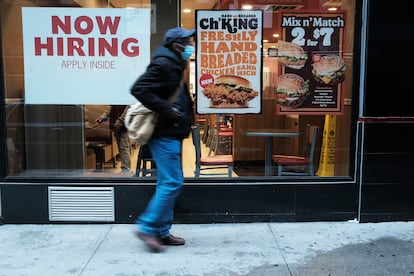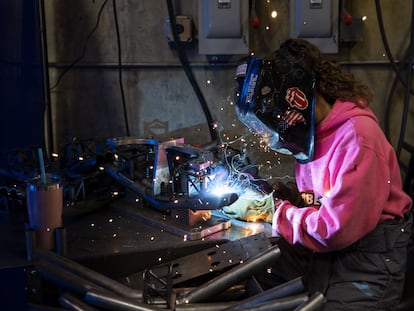Why restaurants in the United States just can’t get the staff
Thanks to the turning point that was the pandemic, employers are being forced to improve wages and offer more flexible working hours. But the American job market is still yet to rebound to pre-Covid levels

Working at a restaurant or fast food chain is something of an initiation rite in the United States. One in every eight Americans has worked at a McDonald’s at least once in their lives, according to the best-selling book Fast Food Nation: The Dark Side of the All-American Meal, by Eric Schlosser. But the Covid-19 pandemic represents a turning point: all the young people who used to fill those positions are now quitting their jobs in large numbers, in a nationwide movement that has been labeled as the Great Resignation.
Even though employers have been forced to improve wages and offer more flexible work hours, the job market has yet to rebound to pre-pandemic levels. The unemployment rate in the hospitality and leisure sectors was 6.6% in February, far above the national average of 3.8%.
The coronavirus made it even harder for companies to find waiters and kitchen workers, but the truth is that the trouble had begun long before 2020. Half-a-dozen experts consulted by this newspaper said there were at least two underlying factors. The first is that young people are moving away from home later than ever (before the pandemic, 47% of 18- to 29-year-olds were still living with their parents, a figure not seen since the Great Depression in the 1930s) and having children later in life. This means that finding a job, even a precarious one, in order to pay the bills is no longer as much of an urgency as it used to be.
The second element is the drop in migratory flows, a trend that began under former President Donald Trump. Immigrants, both undocumented ones and those with legal status, make up 20% of employees in this sector, according to the Pew Research Center.
“We were right at that point where it was going to start to hurt, then the pandemic arrived and everything got completely out of control,” said Ron Hetrick, an economist at Burning Glass Technologies, a US job market analytics firm. After the initial jolt, which was felt particularly hard by the services sector, employers rushed to hire again, but the response was not what they had been expecting. The share of workers who are quitting their jobs has been at its highest level since late 2000 for months, just like the amount of openings.
Every business in this country is hiring simultaneously. We’d never had so much labor competition in the whole history of the United StatesKatie Button, a chef and co-owner of Cúrate, a chain of Spanish restaurants
The shortages are especially noticeable in hospitality, which is missing 1.5 million workers compared with February 2020 figures, according to Labor Department data. According to Hetrick, today’s young generation is taking the additional opportunities to be more selective, and many are choosing to work in food delivery so they can choose their work hours. The government’s stimulus checks against the pandemic also relieved some of the financial pressure felt by twentysomethings.
A wave of early retirements during the pandemic is another factor at play, as is the fact that women, who represent 55% of the workforce in the services sector, were largely in charge of childcare while schools remained closed.
This scenario has forced employers to offer better conditions. This summer, for the first time, restaurant waiters began making over $15 an hour, according to the US Bureau of Labor Statistics. Katie Button, a chef and co-owner of Cúrate, a chain of Spanish restaurants in Asheville (North Carolina) has practically stopped serving lunches because she only has enough personnel for the dinner shift. “Every business in this country is hiring simultaneously. We’d never had so much labor competition in the whole history of the United States. It’s the only explanation for why it’s taking so long to return to pre-pandemic levels,” she said in a Zoom conversation.
Perks
Button and her partner, Felix Maena, were already offering their workers medical insurance before the pandemic – a rare bonus in the hospitality sector – and are now also offering 50% of the worker’s dental plan, up to three weeks of paid vacation and the possibility of raises, among other perks. And Cúrate pays its workers between $18 and $35 depending on the role, compared with North Carolina’s minimum wage of $7.25 for waiters.
Even so, Button said they are struggling to find enough workers. In the decade she’s been working in this industry, she has noticed a change in worker demands: “Now they want paid leisure time, the possibility of work-life balance, full medical insurance, dental insurance... and they won’t accept anything less than a decent wage. I think it makes sense and it’s great.”
Restaurant owners have even resorted to offering shorter working weeks and free subscriptions to the music streaming platform Spotify. Daniel Schneider, a demographer who teaches sociology at Berkeley University and has co-created a database of work scheduling practices called The Shift Project, is skeptical about the real effect of this wave of benefits. “Wages are going up, but so is inflation,” he noted, adding that the minimum wage has not been changed and the work hours remain bad in any case. “This country is not dealing with a ‘jobs’ problem. This is a ‘bad jobs’ problem.”
Tu suscripción se está usando en otro dispositivo
¿Quieres añadir otro usuario a tu suscripción?
Si continúas leyendo en este dispositivo, no se podrá leer en el otro.
FlechaTu suscripción se está usando en otro dispositivo y solo puedes acceder a EL PAÍS desde un dispositivo a la vez.
Si quieres compartir tu cuenta, cambia tu suscripción a la modalidad Premium, así podrás añadir otro usuario. Cada uno accederá con su propia cuenta de email, lo que os permitirá personalizar vuestra experiencia en EL PAÍS.
¿Tienes una suscripción de empresa? Accede aquí para contratar más cuentas.
En el caso de no saber quién está usando tu cuenta, te recomendamos cambiar tu contraseña aquí.
Si decides continuar compartiendo tu cuenta, este mensaje se mostrará en tu dispositivo y en el de la otra persona que está usando tu cuenta de forma indefinida, afectando a tu experiencia de lectura. Puedes consultar aquí los términos y condiciones de la suscripción digital.
More information
Últimas noticias
Most viewed
- Oona Chaplin: ‘I told James Cameron that I was living in a treehouse and starting a permaculture project with a friend’
- Sinaloa Cartel war is taking its toll on Los Chapitos
- Reinhard Genzel, Nobel laureate in physics: ‘One-minute videos will never give you the truth’
- Why the price of coffee has skyrocketed: from Brazilian plantations to specialty coffee houses
- Silver prices are going crazy: This is what’s fueling the rally











































